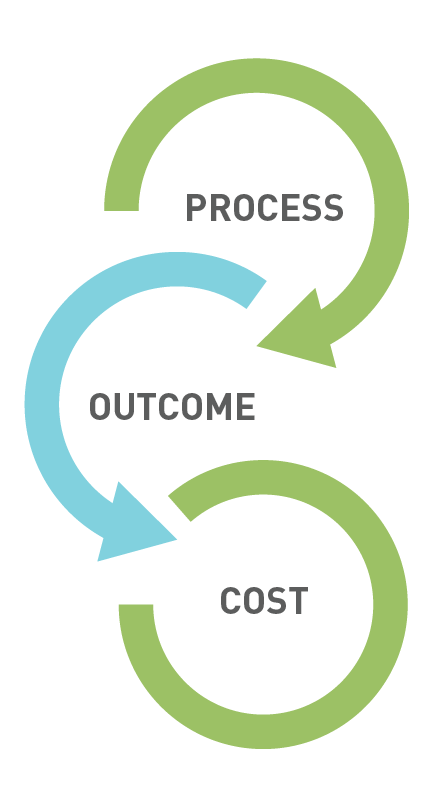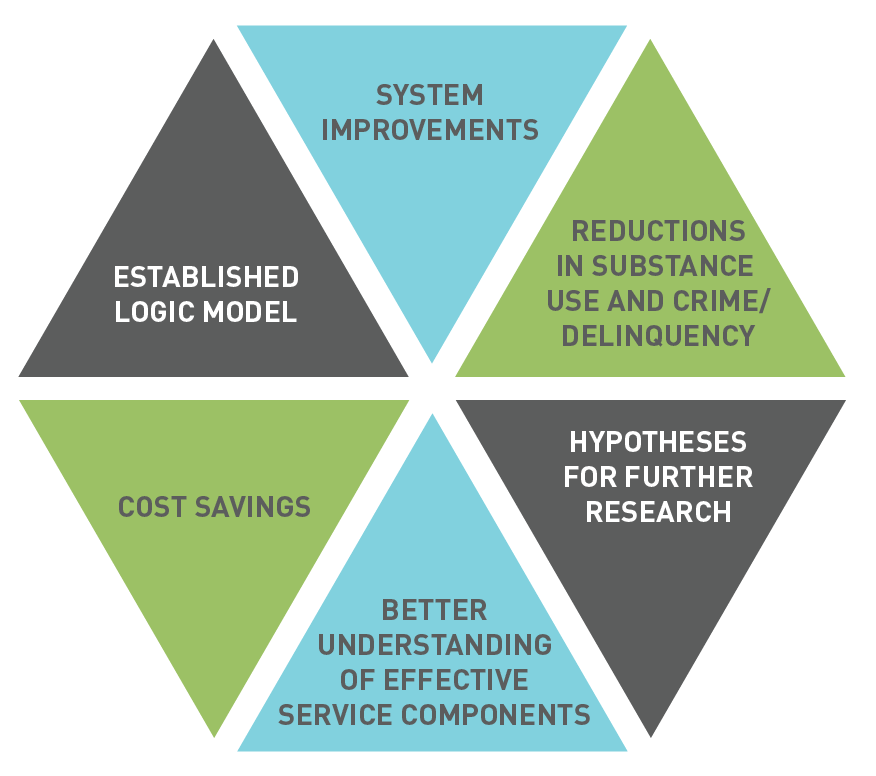
The primary goal of Reclaiming Futures is to identify youth involved with juvenile justice who may benefit from substance use and/or mental health intervention(s) by improving cross-system collaboration and efficiency. To achieve this, we use a multi-disciplinary Learning Collaborative approach and a 6-step model to guide implementation of screening, assessment, and intervention and support coordination.
Since its inception, Reclaiming Futures has worked with researchers and scholars to conduct process, outcome, and cost studies. We prioritize evaluation in all aspects of our work, as demonstrated by the delineation of process and outcome measures in the 6-step model.
Reclaiming Futures sites implement these evaluation measures in various ways. For example, the statewide initiative in North Carolina collects cross-site data to examine implementation barriers and facilitators. Data are used to guide decision making for process improvement(s).
This is not to say evaluating the Reclaiming Futures approach and model has been or is easy or the results have always supported our anticipated outcomes. However, with each evaluation and its results, Reclaiming Futures researchers, scholars, and practitioners have continually improved efforts for implementing plans to improve systems, services, and evaluations. See our reports, publications and bibliography.
Reports and publications 2016 highlights
A report by Butts and colleagues discusses the history of Reclaiming Futures, relevant policy context, evidence-based practices for substance use disorders, and provides an overview of the results from multiple evaluations conducted over the years.
Butts and colleagues surveyed key stakeholders from nine sites each year in 2003, 2006, and 2015. Results show:
Sites that remained strongly engaged over time with Reclaiming Futures reported better access to services and resource management. This suggests the Learning Collaborative approach translates into local system improvements.

The Office of Juvenile Justice and Delinquency Prevention (OJJDP), through an interagency agreement with the Library of Congress, funded the national cross-site evaluation of juvenile drug courts and Reclaiming Futures. Led by the University of Arizona’s, Southwest Institute for Research on Women (UA-SIROW) in collaboration with Chestnut Health Systems and Carnevale Associates, LLC, researchers examined the blended approach of juvenile drug courts and Reclaiming Futures (JDC/RF). The researchers compared the JDC/RF approach to stand-alone juvenile drug courts (JDC) and intensive outpatient (IOPs) substance use disorder treatment programs. As a result of this study, a JDC/RF logic model, peer reviewed journal articles, a special issue of Drug Court Review and numerous reports and presentations have been developed and disseminated and can be found on the UA-SIROW website. Findings showed:
- Youth enrolled in JDC/RF were younger, male, nonwhite, and had higher rates of depression in comparison to the general population of youth who met criteria for JDC (Baumer et. al., 2016)
- Reductions in substance use and delinquency/crime were evidenced over time (Korchmaros, et. al., 2015; The University of Arizona, 2015)
-
Seven program characteristics were found to positively impact substance use and crime/delinquency changes over time including (Korchmaros, et. al., 2016):
- Having a defined target population and eligibility criteria
- Imposing sanctions to modify non compliance
- Conducting random and observed drug testing
- Coordinating with the school system
- Providing gender-appropriate treatment
- Employing policies and procedures responsive to cultural differences
- Training personnel to be culturally competent
- Eight feasible recommendations for engaging the community to improve health and well-being of youth and families are discussed (Greene, et. al, 2016)
- JDC/RF programs produce a net savings of an average of $84,569 per youth (McCollister et. al, 2015).
We are happy to share our results with families, behavioral health service providers, funders, juvenile justice jurisdictions, and community groups. Contact us if interested.
Updated: September 20 2017
